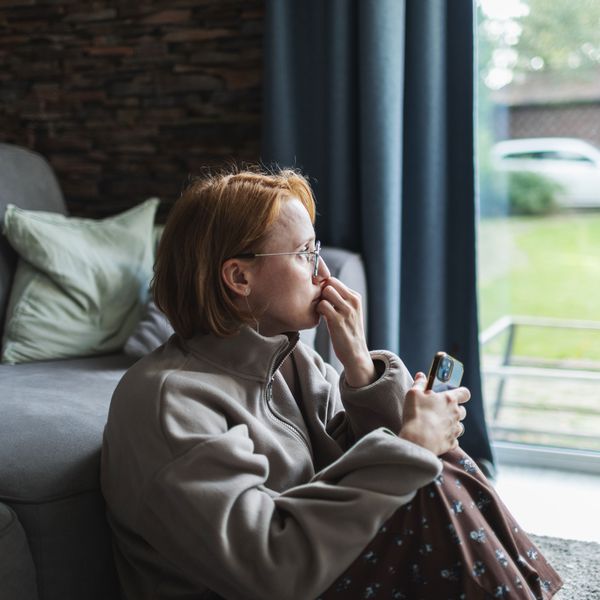:max_bytes(150000):strip_icc()/living-apart-together-getty-recirc-0424-ffa2e1ed6cdc428d91e06bcf2f7a43c9.jpg)
Getty Images / FG Trade
Most couples follow the same path and have the same goals. Long-term romances are often measured by hitting certain milestones, like leaving a toothbrush at each other’s place, giving each other keys to your respective homes or apartments, and eventually, moving in together. For a growing number of duos, however, cohabitating isn't the end game: Instead, they're living apart together (LAT), which, to them, is more romantic than sharing a bedroom, a bathroom, and a permanent address. For these pairs, having separate residences is the secret to a long, happy, and healthy relationship and even marriage.
Curious about this growing trend? We were too, which is why we consulted experts Bella DePaolo, Dr. Sherrie Sims Allen, and Dr. Robert Riordan. Because hey, if it works for Gwyneth Paltrow and her husband, Brad Falchuk, (and thousands of people on Reddit), maybe it’ll work for you, too. “We are in a whole new era of couples living apart,” DePaolo affirms. In fact, according to the United States Census Bureau, 3.89 million Americans are living in separate quarters from their spouses (which makes up 2.95 percent of all U.S. marriages).
Couples used to live apart mainly because they had no choice—perhaps one or both parties had great jobs in different cities or countries that they just couldn’t give up, for example. Sure, that’s still the case for some LAT couples, but the trend of intentionally choosing to live apart, regardless of your job situation, is on the rise. “What is relatively new, or newly getting recognized, are the couples living apart because they want to—or at least one person in the couple wants to," she says.
Meet the Expert
- Bella DePaulo is an academic, researcher, and author of How We Live Now: Redefining Home and Family in the 21st Century.
- Sherrie Sims Allen, Ph.D. is a psychologist and relationship expert based in Los Angeles.
- Dr. Robert Riordan is an attorney and clinical psychologist who specializes in couples therapy. He has a private practice in New York City and Connecticut and is the founder of Blueprint, an immersive couple therapy retreat located on the Connecticut shoreline.
Just like people are choosing to marry or have children later on, some are choosing to go a different route when it comes to their marriage. Especially for people who have spent their twenties and thirties single and living alone, independence can be tough to give up. “I see it as a possible growing trend as singles look at ways to connect that won’t cost them their preferred lifestyle or way of life,” Sims Allen offers. According to Riordan, data supports that this model works. "Research has demonstrated that LAT relationships successfully support a viable romantic connection while offering higher levels of relationship satisfaction."
Curious about maintaining an LAT romance? Ahead, we detail what living apart together actually looks like, motivations behind LAT lifestyles, the pros and cons, and how to make it work for you.
What Does Living Apart Together Mean?
Key Takeaways
- Living apart together (LAT) involves maintaining a romantic relationship and separate homes indefinitely.
- LAT living situations vary. Some couples live in different apartments in the same building or on opposite sides of a neighborhood. Other duos live in entirely different cities or even states.
- A lot of couples choose to live apart together intentionally and believe this setup improves their relationship or marriage.
Living apart together (LAT) refers to couples who are in a committed romantic relationship, but who choose to live in separate places. "Some couples live in the same apartment building; some on the same street," Riordan says. "Some have houses next door to one another. In some cases, one member lives in an urban area and the partner enjoys the peace of a home in a nearby suburb."
Although there are various reasons why a couple might live in different residences (from financial to personal), they typically make the intentional choice to pursue this type of relationship for the benefit of their partnership. "In our society, we erroneously assume that all unmarried couples who live apart are temporarily navigating financial or geographic challenges that, once resolved, will lead the couple to live together," Riordan says. "Further, it’s a forgone assumption that all married couples cohabitate. Yet, a growing number of couples—both unmarried and married—are making the choice to live separately on a permanent basis because they believe this arrangement fosters their best romantic connection."
How Living Apart Together Compares to Long-Distance Relationships
Now that you have a better understanding of what LAT relationships entail, you might be wondering how this type of partnership differs from long-distance relationships. While both concepts involve partners living in separate households, they’re entirely different arrangements. LAT couples usually make the intentional decision to live apart from one another, a living situation that they agree will improve their relationship. With long-distance relationships, on the other hand, there is usually an external factor that prevents both individuals within the union from living in the same space—they’re geographically separated due to school, work, or family circumstances. For that reason, they meet up less frequently than LAT couples and aren’t as embedded in one another’s social circles.
:max_bytes(150000):strip_icc()/living-apart-together-reasons-getty-images-18f13c2a0bc34ca88e93f9db505bc672.jpg)
FG Trade / Getty Images
Reasons Why Couples Are Living Apart Together
Couples decide to live separately for different reasons, whether it’s because they love their solitude and space, they have to be in different locations for work or financial reasons, or because they feel like not being together all the time actually strengthens their bond. Here are some of the most common reasons why couples are embracing this relationship model:
Need for Autonomy
Those who highly value their independence find living apart together appealing. By residing in different homes, each partner has autonomy over their space and the ability to spend time in solitude whenever they please, all while enjoying the benefits of a romantic relationship. “Living apart might offer some relief to couples who value their individual space, as well as each other,” Sims Allen says.
Professional Demands
Some couples may choose to live apart due to demands from their respective careers. If you both have established jobs on opposite sides of the country, but you meet on a cross-continental flight and fall in love, for instance, you might decide it’s best for both of you and your relationship to keep your jobs (at least for a few years).
Financial Limitations
In some cases, spouses might start their marriage living together in a house that they either bought or mortgaged, but due to financial limitations, they decide to save money by downgrading. Instead of funding a smaller home, they might decide that it's more practical and cost-effective to live in separate apartments. This depends on the arrangement, of course: Moving to separate homes would be more expensive than living in a single household.
Preexisting Families
If either or both partners have children from a previous relationship, it might make more sense for the pair to reside in separate places. Perhaps, they want to give their kids a semblance of normalcy or maybe their children are already situated in their schools and friend groups, so fully blending families would cause a significant disruption to their daily lives and personal wellbeing.
Incompatible Lifestyles
Then, there are those in committed relationships who choose to live apart due to conflicting lifestyles, habits, and preferences. This might look like incompatible sleep schedules, mismatched expectations for household cleanliness, or inconsistent desires for their place of residence.
Why Living Apart Together Is a Growing Trend
The LAT movement is an appealing model for many couples, and its presence is only increasing. Because individuals in our modern society continue to challenge preexisting norms, living apart together reflects this broader societal push for more inclusivity and acceptance of nontraditional arrangements. This relationship model challenges the existing framework of what a committed romantic union looks like, claiming that cohabitation isn't required and that singleness and partnership aren't mutually exclusive concepts. So, as individualism and equality prevail, many people find that traditional marriages don't suit them—and they feel empowered to choose a more personally fulfilling route.
Individualism
With the emphasis on individualism in our society, LAT arrangements are becoming more and more enticing to some couples. Since people in individualistic cultures are used to going about life in a way that caters to their own personal preferences and freedoms, it makes sense that some would want to preserve that sense of autonomy in their relationship.
Feminism
According to Riordan, women have largely driven the LAT movement as a way to turn gender norms on their head. Older generations are embracing this relationship model to rebel against their past roles as traditional housewives. "Favored by many older women who spent decades living under the same roof as their partners, these women report that the freedom and independence associated with an LAT relationship is too precious to give up," he explains. "After years of taking care of their husbands and children, these women seek a new chapter (with the same or a new partner) where their individual needs are at the forefront."
Younger generations of women are also taking notes. "Young women—having taken cues from their elders—are seeking to avoid a living situation in which they are unfairly burdened with the labor, both actual and emotional, of being in a conventional one-residence relationship," he continues. "They have grown up with an independence that they are reluctant to give up."
Social Justice
Individuals in our modern age are much more tolerant of personal differences, which includes people's relationships. Since society is more open to and accepting of diversity across various sectors, couples who choose to live apart are less likely to receive any societal pushback—and it’s empowering couples to select a relationship model (living apart together included) that works for themselves, regardless of what others might think.
The Pros of Living Apart Together
Having your own space while being in a loving relationship has plenty of benefits, from maintaining your individualism to decreasing the likelihood of arguments.
Prioritization of Your Own Needs
Living apart means decorating however you want, making your own schedule, or seeing friends and relatives without feeling guilty about splitting time with your spouse. "Each partner can sleep when they want, be as messy as they want, and be as loud as they want," Riordan says. "Each member of the couple invests heavily in his or her own individual needs and wants."
Fewer Cohabitation Challenges
According to Sims Allen, married couples who choose to live apart can have a “rich and intimate life that focuses on the heart of the relationship and not the daily details of existing together and running a household.” Meaning, your relationship won’t be defined by the daily stresses of whose turn it is to take out the trash or who didn’t close the kitchen cabinets.
Having breaks allows your time together to focus solely on bonding and spending quality time, instead of just time. DePaolo says that when LAT couples are together, “they focus on what they enjoy about each other and don’t spend a lot of time fretting about the small stuff.”
Less Conflict
Living apart together reduces the pressure points in a relationship, says Riordan, who affirms that couples who live apart often engage in less conflict. "LAT relationships have fewer 'sharp edges,' because the couple often retreats to its separate living quarters before conflict escalates," he explains. Having their own respective spaces gives both partners the ability to process their emotions and sort out their thoughts instead of acting on an impulse and offending the other.
Increased Spark
Arguably one of the biggest benefits of living apart together is that perennial spark. "LAT couples make this decision based on a genuine belief that distance makes their heart grow fonder," Riordan says. "They embrace a longing for their partner and credit the distance with the evergreen spark in their relationship." After spending a considerable amount of time apart, you’ll appreciate the time you spend together even more, which can make partners feel more appreciative of the other and their connection.
The Cons of Living Apart Together
Although LAT relationships have plenty of benefits, there are disadvantages to the arrangement, too. Whatever challenge you're facing, the key to combating any of these relational issues, according to Sims Allen, is remaining flexible: Communicate when things aren’t working, and stay open to going the more traditional route if it’s worth it for both of you.
Financial Strain
Depending on the living arrangement that the couple settles on, some LAT setups aren't always cost-efficient. "LAT relationships come with the financial challenge of maintaining two households," Riordan says. "For many couples, this option is simply not feasible."
Heightened Insecurities
Also, if there are any insecurities in the relationship, jealousy can come into play if one or both partners feels like they’re being ignored, or if they worry about where their spouse is, what they’re doing, and who they're doing it with. "Above all, the greatest downside of an LAT relationship is that what makes it special—namely, distance—also has the potential to create the most pain," Riordan notes. "When we are deeply in love, we want physical proximity to the object of our desire. Distance from the object of our affection can stir up jealousy, insecurity, and loneliness. Distance also understandably increases our fears about our partner’s fidelity." There’s also the possibility that you’ll grow apart and seek out a new love who lives closer to home—after all, duos in LAT relationships do miss a great deal, Riordan says.
Communication Challenges
Because partners in LAT relationships are living apart from one another, it might be more difficult to communicate effectively. Instead of popping into the other room to ask your significant other a question, like those under the same roof can do, you'll instead have to reach them electronically, which isn't always the most convenient route. In order to stay connected, it's important to set up a plan for consistent communication.
:max_bytes(150000):strip_icc()/living-apart-together-talking-on-phone-getty-images-4fefebc6e7aa478fb3bf098bf9d82e4b.jpg)
bluecinema / Getty Images
How to Make Living Apart Together Work for Your Relationship
If living apart together sounds like the ideal arrangement for your relationship, it requires commitment and effort to make it work. Here's how you can implement this living arrangement:
Agree to the Arrangement
Having some alone time sounds amazing to most couples at some point, but make sure you’re fully committed to separate addresses and daily lives before jumping into the LAT lifestyle. Before you make any decisions, it’s essential that you have a conversation with your significant other about living apart. Both partners will need to be on board—or at least willing to try—the living situation before you make any arrangements. Be clear about why you want to live apart, and make sure one partner isn’t agreeing just to please the other. “The question becomes whether you are strong enough in your commitment to your relationship to withstand living in separate households,” Sims Allen says. Remember that you aren't locked in to this type of relationship: At any point, whether it's in a few months or a few years, you can make adjustments if needed.
Define Expectations
Once you both decide to try an LAT living situation, clearly define your expectations, so you both know what you’re signing up for. If you have kids, when will each of you take over childcare duties and what will that look like? How will you split the bills? How will you navigate any potential challenges that arise due to the living situation? Be sure to come to an agreement before you move to separate households.
Try a Test Run
Riordan suggests a test run for couples on the fence. "If both parties feel that an LAT relationship would help their romantic connection thrive, the couple should do a three-month trial run," he shares, noting that this isn't for the faint of heart. "One party should find a sublet or rent a furnished Airbnb or VRBO so that the couple can test out the pros and cons of this arrangement. Let me be clear, though: The arrangement will fail if one party’s heart is not fully in this decision. The ambivalent party will have a very different—and, likely, very painful—experience during this trial period of distance."
Schedule Time Together
Having your own space is a huge draw for many people in LAT couples, but setting aside time to spend with one another will help make your time alone even more rewarding. Schedule weekly dates and book a weekend getaway every now and then to make sure that you’re in each other’s presence.
Prioritize Communication
Living in two separate quarters can present issues with communication, so be sure to make it a priority. Discuss your needs and how your partner can meet them, set boundaries when needed, and regularly praise your partner’s strengths. That said, it’s also important that you both respect each other’s privacy and personal space, so excessive communication isn’t the goal, either. Be sure to establish parameters on when it is and isn’t appropriate to reach out.
Embrace Your Decision
If living apart together is the best living situation for you and your partner, do what works for the preservation of your union. Sims Allen says she knows of a couple where the husband lived in South Africa and the wife was in New York. They loved where they each lived, loved their jobs, and they loved each other, so they, like a growing number of couples, made it work. “Having a place of your own just isn’t that unusual anymore,” DePaulo says. “Sometimes, it is living with someone else that takes some getting used to.”
Questions to Ask Before You Try Living Apart Together
Setting a few boundaries before you go your separate ways together is the key to success, notes Riordan, who says to ask the following questions before you commit:
- What are each party’s expectations about frequency of contact? Will there be daily interaction? Calls? Texts? How available will each party be to the other?
- What is the agreement around accountability? Do you expect your partner to always inform you about their whereabouts and/or with whom you are spending your time? Is romantic and sexual fidelity expected?
- What are the financial expectations now that the couple is managing two households? Who will pay for what?
- What is the messaging you will share with third parties, like parents and friends? It is crucial to be a united front here for the couple’s own solidity.
- Is this arrangement the end game? It can be very hurtful for one party to secretly hope that this arrangement is just a “phase.”
















